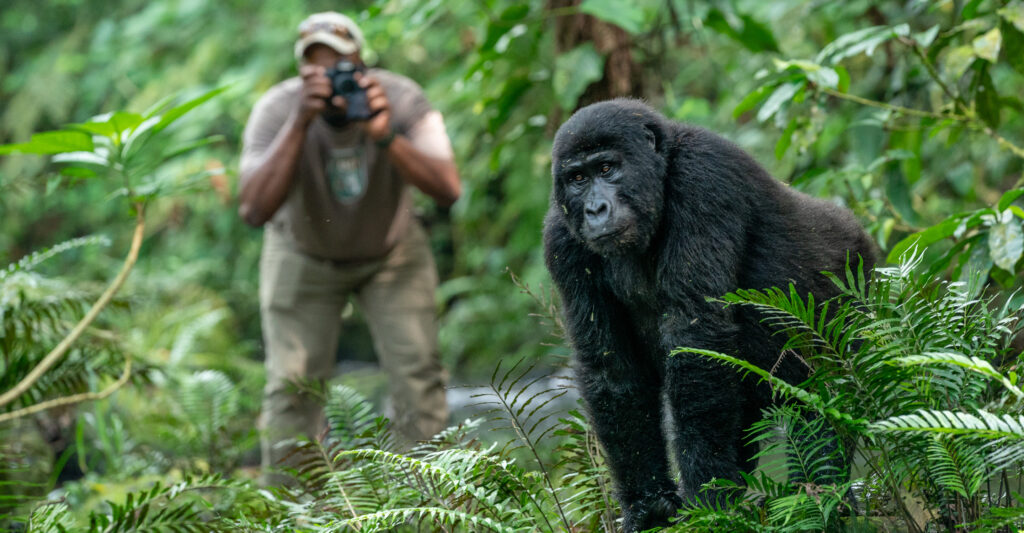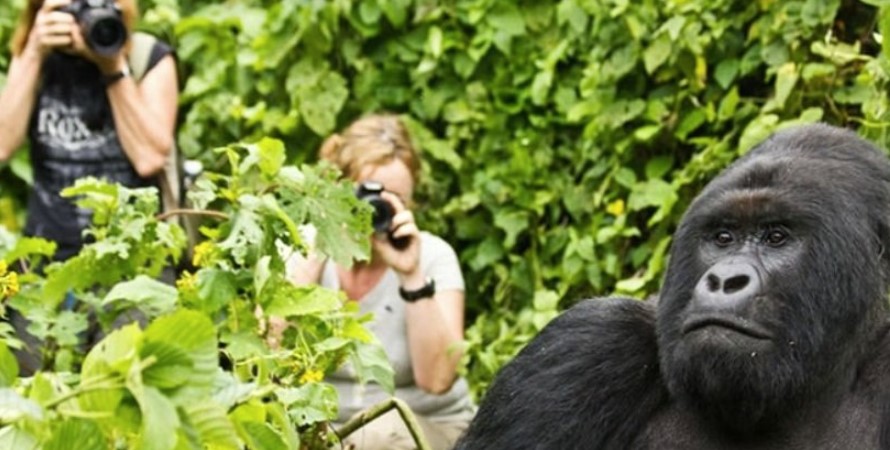How to photograph Gorillas in Uganda
How to photograph Gorillas in Uganda, What are the techniques for photographing gorillas in Uganda? Capturing images of gorillas in Uganda is a remarkable experience in Mgahinga Gorilla National Park and Bwindi Impenetrable Forest National Park. This is a comprehensive guide to assist you in capturing optimal photographs of gorillas in Uganda while following ethical principles.

Preparation
Select the Appropriate Camera and Equipment:
Camera: Utilize a DSLR, mirrorless camera, or a premium point-and-shoot device.
A zoom lens with a focal length of 70-200mm or 100-400mm is optimal for capturing both close-up and environmental images.
Additional items: Bring extra batteries, memory cards, and a lens
Cleaning apparatus.
Protection: Carry a rain cover for your camera and lens because of the jungle conditions.
Configurations:
ISO: Configure a high ISO setting (800-1600 or greater) due to the diminished light conditions in the forest.
Utilize a broad aperture (f/2.8 to f/5.6) to enhance illumination and get a shallow depth of field.
Shutter Speed: Maintain it above 1/250 sec to immobilize motion.
Don Suitable Attire: Neutral, subdued hues to harmonize with the surroundings.
Long-sleeved shirts and pants for protection against insects and vegetation.
Ergonomic hiking boots and gloves for traversing challenging terrain.
Throughout the Expedition
Adhere to Regulations and Protocols:
Ensure a minimum separation of 7 meters (or as recommended).
Refrain from use flash photography, as it may disrupt the gorillas.
Honor the gorillas’ innate behaviors; refrain from provoking or engaging with them.
Prepare for the Environment: The forest may be dense and muddy; therefore, be ready to adjust your angles and positions.
Utilize a monopod or place your camera on a stable surface if required.
Monitor Conduct: Concentrate on facial expressions, interactions, and distinctive behaviors.
Document the silverback’s supremacy or the amusing antics of juveniles for diverse imagery.
Guidelines for Composition
Utilize adjacent vegetation to encase the gorilla for a natural appearance.
Conduct experiments utilizing close-up portraits and expansive images that depict their environment.
Angles: Capture images at eye level or below to achieve an intimate viewpoint.
Avoid directing your camera into the gorillas’ eyes for prolonged durations, as it may be interpreted as a threat.
Utilize gentle, diffused illumination throughout the forest.
Recognize pronounced contrasts between illumination and shadow, and modify exposure accordingly.
Storytelling: Pursue images that convey a narrative, such as a woman caring for her infant or a collective engaged in foraging.
Post-Expedition Recommendations
Edit with Care: Modify exposure, contrast, and color balance to emphasize the details.
Crop as needed to enhance composition while maintaining the scene’s authenticity.
Promote Conservation: Highlight the beauty and fragility of gorillas by sharing photographs that underscore their significance.
Supplementary Advice on Photographing Gorillas in Uganda
Consider reserving a gorilla habituation session, which permits extended observation (up to 4 hours) for photographing the gorillas in Bwindi.
Engage a porter to transport equipment, allowing you to concentrate on photography.
Exercise patience; gorillas exhibit unpredictability, and the optimal
Opportunities frequently arise from patience.
Uganda is acclaimed for its exceptional gorilla trekking opportunities in the verdant rainforests of Bwindi Impenetrable National Park and Mgahinga Gorilla National Park. The principal gorilla trip choices offered in Uganda are as follows:
1. Conventional Gorilla Trekking
- Location: Bwindi Impenetrable National Park (comprising four regions: Buhoma, Ruhija, Rushaga, Nkuringo) or Mgahinga Gorilla National Park.
- Duration: One day or longer (contingent upon your schedule).
- Description: Observe a habituated gorilla family in their natural habitat for one hour. This is the most favored choice among visitors.
- Permit Fee: $800 for non-residents, $700 for residents, UGX 300,000 for East African citizens.
2. Gorilla Habituation Encounter
- Location: Rushaga Sector, Bwindi Impenetrable National Park.
- Duration: 4 hours in the presence of gorillas.
- Description: This enables participation with researchers and trackers to observe semi-habituated gorilla families. You will get knowledge on their behavior and assist in the habituation process.
- Permit Fee: $1,500 per individual.

Distinction between Gorilla trekking in Bwindi Impenetrable Forest National Park and Mgahinga Gorilla National Park
Bwindi Impenetrable National Park and Mgahinga National Park are the sole national parks in Uganda that facilitate gorilla trekking. These habitats include over 50%, or half, of the global Mountain Gorilla population. Additional national parks for gorilla trekking are Volcanoes National Park in Rwanda and Virunga National Park in the Democratic Republic of Congo.
If you are struggling to decide between Bwindi Impenetrable National Park and Mgahinga National Park for gorilla trekking in Uganda, the following comparison, based on our expertise, will assist you in making an informed choice regarding your trekking experience in these two parks.
Both Bwindi Impenetrable Forest National Park and Mgahinga National Park harbor mountain gorillas, and there is minimal distinction in the experience garnered upon completion of your walk. There are several criteria upon which to compare gorilla trekking in Bwindi Impenetrable National Park and Mgahinga National Park to assist in your decision of where to schedule your gorilla trekking experience, including the following:
Mgahinga National Park’s mountain gorillas inhabit the Virunga mountains, characterized predominantly by bamboo vegetation, whereas Bwindi Impenetrable Forest National Park features these gorillas within a dense, impenetrable tropical rainforest comprising diverse tree and plant species. Mgahinga National Park gorillas are considered more visible due to the kind of vegetation, facilitating clearer photography compared to Bwindi, where gorillas inhabit dense forests.
Both Bwindi and Mgahinga National Parks are accessible by road or air. Traveling by car from Kampala/Entebbe requires an 8-9 hour trip through Kabale town, continuing to Bwindi or Kisoro to reach Mgahinga National Park. Accessing Bwindi and Mgahinga National Park is also feasible via Kigali, resulting in a drive of only 4-5 hours. Upon arrival in Kigali, utilize the East African Tourist Visa, which permits simultaneous visits to both countries, and subsequently embark on a cost-effective gorilla trekking expedition in Uganda.
Both National Parks offer budget, mid-range, and upscale lodges for accommodation during your trek. Bwindi Impenetrable National Park is the premier destination for gorilla trekking for individuals seeking accommodations in ultra-luxurious lodges that meet international standards in comparison to Bwindi. These lodges provide exceptional luxury services, with several regarded among the finest in Africa and the country, such as Gorilla Sanctuary Forest Camp, Clouds Mountain Gorilla Lodge, and Buhoma Lodge, among others.
Bwindi Impenetrable Forest National Park possesses a greater number of gorilla families available for trekking compared to Mgahinga National Park. Bwindi hosts 19 habituated gorilla family groups, resulting in 152 gorilla permits accessible daily for hiking. Mgahinga National Park hosts a solitary Gorilla family, resulting in the availability of only 8 Gorilla permits daily for trekking activities. This renders the acquisition of gorilla trekking permits in Bwindi more adaptable than in Mgahinga National Park, particularly during peak season months.
The distance required to observe gorillas in Bwindi Impenetrable National Park compared to Mgahinga National Park varies according on the specific gorilla family assigned to you on the day of trekking in either national park. In both Bwindi Impenetrable National Park and Mgahinga National Park, gorilla families are assigned based on the interests and physical fitness of the individual. If, for instance, you desire a shorter walk, you must notify the park authorities on the day of the trek to be assigned accordingly. If you desire a medium or extended excursion, then you proceed similarly. It is important to acknowledge that although they will attempt to provide you with a family that necessitates fewer trips, the behavior of the gorillas may influence the experience; for instance, if the gorillas choose to relocate while you are searching for them, you may be required to traverse a greater distance.
Bwindi Impenetrable Forest National Park is in closer proximity to other National Parks than Mgahinga National Park. A mere two-hour drive allows access to Queen Elizabeth National Park for big game wildlife observation, while a four-hour journey leads to Kibale Forest National Park for chimpanzee trekking, facilitating the seamless integration of your unforgettable gorilla trek with additional adventures in other parks.
Best period for photographing gorillas in Bwindi Impenetrable National Park and Mgahinga National Park
Both parks facilitate gorilla trekking year-round; nevertheless, it is crucial to acknowledge that the forest is a tropical rainforest and may experience precipitation at any moment. The optimal months for gorilla tracking are June to August and December to February, as these periods experience minimal rainfall, resulting in less slippery forest conditions. Conversely, traveling between March and May, as well as in November, may result in increased rains, but you may also receive discounts on accommodations from certain lodges.
